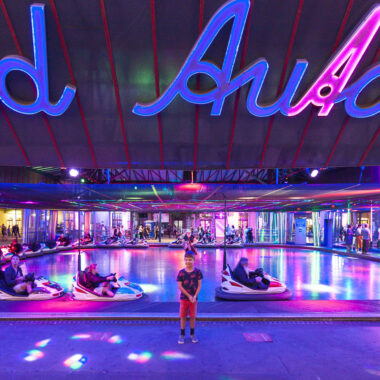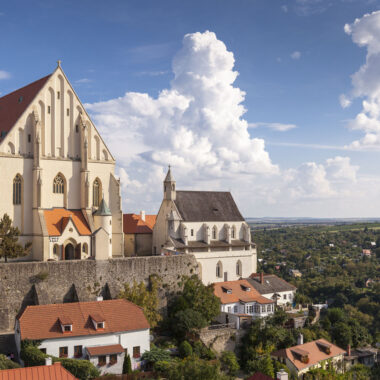A train from Ljubljana to Villach, and then Villach to Vienna was the plan. The first train – from Ljubljana to Villach – was on a daily train that ran across four countries between Zagreb in Croatia to Frankfurt in Germany. As we were waiting for the train in Ljubljana the departures board showed a delay of 30, then 40, and ultimately 52 minutes. No way we were making our connection from Villach to Vienna. In typical Austrian fashion – or anywhere where the primary language is German – the Austrian rail operator OBB sent another train on time to Frankfurt from Villach instead of inconveniencing all the travelers in Austria and Germany. That meant all the poor travelers on our train that were supposed to be traveling to Frankfurt had to find other means of transport. More important for OBB to maintain its spot on top of the most punctual rail operators in Europe. For us it wasn’t that much of an inconvenience, it just meant we ate lunch on the platform in Villach instead of on the train to Vienna. Whilst we were sitting there, I saw a couple of mountain bikers strolling through the station all kitted out in riding gear with some beastly long travel DH bikes, obviously just finishing a ride and heading home on the train. Maybe we should have stopped in Villach for a night or two after all!
Get Directions
Unlike a lot of other European cities we’d visited this far, Vienna’s layout didn’t lend itself well to staying in the central part of the city. We shacked up for our stay in Landstrasse, Vienna’s third district, which was a roughly 20 minute tram or train ride from all the main attractions. Our lodging at Jimmy’s Three was one of our favorites thus far, a beautiful fort-like apartment in the penthouse where every room had an angled roof with windows that we could open to see views of the Vienna skyline. We have made it a bit of a habit to explore cities on foot thus far, but Vienna is a lot more spread out than Paris and Rome so we sprung for a couple of Vienna city cards to allow us unlimited travel on all the public transport whilst in town. The Viennese public transport ran with clockwork-like precision, with trams, buses and trains never a minute late. And they were so clean. It was a great way to explore the city.
What was a little annoying about Vienna was the attitude towards COVID. When we visited, Vienna remained the only EU city requiring children under 12 to be tested for COVID to access hotels, public attractions and restaurants. At the time of writing, nowhere else even in Austria required COVID tests for kids under 12. Just Vienna. We even had to have the kids tested for COVID in Ljubljana prior to hopping on the train on Thursday before our Viennese apartment would provide the access code to our apartment. Every single restaurant at which we ate in Vienna asked for our COVID vaccination cards and the kids’ COVID test results. To see the Lipizzaner stallions perform at the Spanish Riding School on Sunday Lilia had to have a COVID test. In the space of four days Lilia had five COVID tests and Max had four. A real PITA (although Vienna did provide free COVID tests to anyone who wanted one, so the only thing it cost us was time…). At the time of writing, just 170 miles/270 kilometers south in Zagreb the incidence of COVID was exactly the same as in Austria. The ironic part is that Vienna policed face masks, COVID tests and vaccination status with military-like fashion while in Croatia COVID was a complete afterthought when we visited. In Croatia we weren’t even asked for our vaccination status when we passed through immigration, let alone required to wear face masks on public transport or in restaurants. I shouldn’t complain too much, though, as while I was getting the kids their many swabs at one of the city test sites at Wollzeile 27A Lisa had the chance to explore some of the surrounding neighborhood. She enjoyed a cappuccino at nearby Café Konditorei on one visit, discovering in the process that cappuccino is actually an Austrian beverage that was introduced to Italy by Austrian soldiers. And on another occasion she discovered the bakery at Öfferl just down the street, which had on offer some of the best baked goods I’ve ever had the fortune to sample. Their rye and sourdough loaves looked exquisite, something for another visit. There was even a Hillinger wine tasting room just near the Wollzeile city COVID test site, so Lisa was kept more than busy while I toured the kids through this current chapter of pandemic management.
Enough griping… While Vienna was bombed during World War II – resulting in a loss of 20% of the city to conflict – the majority of important architecture was perfectly preserved. The central Innere Stadt first district was a beautiful example of Baroque architecture, with an endless array of impressive buildings lining the cobblestone streets. The architecture coupled with the horse-drawn carriages that seemed to be everywhere on the streets had us feeling a little like we were in a fairytale as we were traipsing about town. Lilia, with her love of horses, was so enamored with all the carriages. Saint Stephen’s Cathedral in the center of Innere Stadt was a commanding structure, with its towering spires and majestic interior. We visited whilst mass was in session, quite memorable for all of us to be inside the church while the booming pipe organ was belting out hymns. We made the mistake of eating lunch from one of the stalls hawking traditional Viennese food in an alley surrounding the cathedral, I should have known to ask prices before ordering when there we no prices posted! The food was quite delicious, although double the price had we walked one block away from the bustling tourist area next to the cathedral. Adjacent to Saint Stephen’s was Graben, a pedestrian street lined with a dizzying array of high end storefronts. Everything from Hermes to IWC, Burberry to Louis Vuitton. It was interesting to field questions from the kids as they were looking in the windows like, “Why would someone spend that much money just to tell the time?”
The Hofburg – the former principal imperial palace of the Habsburg dynasty built in the thirteenth century – was also well worth the time we spent strolling from end to end. Structure after structure with such beautiful architecture, so impeccably maintained and presented. From Michaelerplatz at one end to Maria-Theresien-Platz at the other the Hofburg complex stretched almost half a mile.
It was a big change in cuisine from Ljubljana to Vienna, with the eclectic fare in Slovenia’s capital replaced by wienerschnitzel, sausages and potatoes prepared in a variety of fashions. I’m not one to ever decline a good schnitzel, and there were some great offerings we sampled in Vienna, but it was a marked switch to meat and potatoes from all the wonderful food we’d enjoyed in Slovenia and Croatia. We had fun sampling all the Viennese meats at Gasthaus Kopp one night, made all the more enjoyable by our jovial waiter, and also had a great meal on another evening at Heurige Zur Alten Weinpresse near our apartment. Some of the best schnitzel I’ve had at Heurige Zur Alten Weinpresse and the goulash was absolutely otherworldly. A visit to Vienna wouldn’t be complete without warm apple strudel with custard, so we visited a Viennese landmark at Café Landtmann for a mid-afternoon dessert coupled with some adult drinks for Mum and Dad. It was delectable. It had me visualizing the strudel scene from Inglorious Basterds, Christoph Waltz even had me scared in that portion of the movie!
We devoted a morning to exploring the Naschmarkt in Vienna’s sixth district. It was one of the largest open air markets I’d ever seen, stretching close to a a mile/1.6 kilometers from end to end. Along its length there was between two and three rows of stalls with everything from fine dining to fruits and vegetables to an open air flea market at one end. Such a dizzying array of produce on offer, it was a lot of fun to spend a couple of hours taking in all the sights, sounds and smells. Lisa stumbled onto a free bike track for the kids at the southern end of the market, they’d both been missing their bikes since we packed them up in California so it was great for them to be able to put in a bunch of laps around the small street circuit. We enjoyed lunch at an Israeli falafel and kebab stand tucked into the Middle Eastern section ofNaschmarkt, my Israeli-style curried chicken pita was exceptionally delicious. I think we could have gone back toNaschmarkt for lunch every day for a week and not have even scratched the surface.
We also spent a solid chunk of one day taking in the Schönbrunn Palace. Often compared to Versailles in Paris, Schönbrunn Palace was the main summer residence of the Habsburg rulers of Austria. The 1,441-room Rococo palace is one of the most important architectural, cultural, and historic monuments in Austria. The history of the palace and its vast gardens spans over 300 years, and has been a major tourist attraction since the mid-1950s. As we were walking about the grounds we noted to the kids that the palace was the summer residence of a single family back in the day, something they were quite astonished to learn. The palace was wonderfully presented with ornate gardens and not a piece of any of the buildings showing any signs of wear and tear. Unfortunately no photos were allowed inside the palace, but I did snag some good shots of the grounds and our time exploring the maze and labyrinth. The kids both had a hoot in the maze, Max was quite concerned he was going to get lost (which was a distinct possibility). It took us a little over an hour to explore the maze and two labyrinths, well worth the ticket price.
There were a couple of highlights for the kids in Vienna, as well. Some seriously overflowing passion buckets from both of them as we ventured to Prater – Vienna’s permanent amusement park in the center of the city – one night after dinner. I think it was the latest they’d got to bed since we left California in early June. “Just one more Dad?!” More irony in Viennese COVID management: COVID tests were required for children to eat outdoors at a restaurant, but the permanent amusement park was open to all comers. Go figure. Without a doubt a highlight for Lilia was also the visit she and Lisa made to one of the performances at the Spanish Riding School. The Lipizzaner stallions that perform the dressage at the school are part of a tradition that stretches back to the Habsburg Monarchy in 1572. It is the oldest riding school of its kind in the world. Unfortunately no photos allowed inside the school (what is it with Austrians and no photos?!) but both Lisa and Lilia were quite impressed with the performance and the riders’ control of the horses.


































































































































































Pingback: Moravian Wine Country – Our Walkabout Two
Pingback: Madrid - Our Walkabout Two